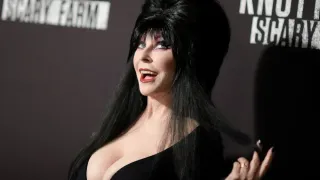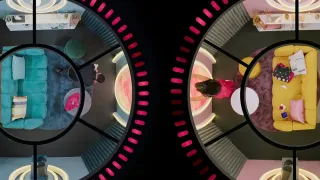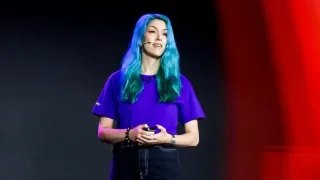August 4, 2021
Udo Kier on His 50-Year Career and 'Swan Song'
Brian Bromberger READ TIME: 13 MIN.
At age 76, gay German actor Udo Kier is having the time of his life, because he has just played the role of a lifetime. Kier stars in Swan Song, directed by Todd Stephens, as gay retired Sandusky, Ohio hairdresser Pat Pitsenbarger. Living in a nursing home, he's lured back into work (to the tune of $25,000) to dress up the corpse of a former rich client (played by Linda Evans).
Kier, known primarily as a character actor, has appeared in 200+ films for half a century. He spoke (with a thick German accent and almost non-stop) by phone from his home in Palm Springs –where he's a local celebrity– with the Bay Area Reporter.
It's as if he recognizes this is his big moment and he's trying to keep pace with all the great things Swan Song is doing for his career. He proudly announces that he lives in a former library.
"I've collected artwork all my life with paintings by David Hockney, Matisse, and Andy Warhol. I also collect furniture including George Nelson and Eames, whose chair I'm sitting in now as we speak. I bought them all many years ago."
When asked whether Pat was written for him, Kier replied, "Absolutely not. I heard from my agent that Todd had been casting the part for almost a year and somebody gave him the idea of me playing the role. So Todd sent me the script, even though I had never seen a film he had ever directed. Even now I haven't seen any of his films.
"I liked the script. When I make independent films, I have to like the director. I wanted him to visit me in Palm Springs. He came here and we had lunch. We were laughing the whole time. I liked him right away. We did crowd-funding for the film, and through my fans and people who knew me, we raised several thousand dollars."
For Kier, it was important to shoot the film chronologically.
"That's why we started in the nursing home. I demanded some time alone there without a camera, without a director, just me living in that small room and sleeping on my bed. I wanted to discover my room, since I had been living in the home for years. I had to know what was in every drawer. When I look out the window, I asked what do I see, so I would stare at it for hours. It's part of being an actor to get a sense of your surroundings."
Studying Sandusky
Pat is based on a real-life person Stephens knew in Sandusky. Aside from being gay, Kier didn't see any similarities between himself and Pat.
"It had nothing to do with me," he said. "I adapted the character. I'm not a hairdresser by trade, nor have I ever worn a green suit and a strange hat (both of which figure prominently in the film). Of course, in Germany when AIDS came, I lost friends because there weren't any medications like there are today, thank God, in which the virus is made undetectable." [Note: Pat's partner in the movie died of AIDS in 1996.]
"I did not want to go over the top," said Kier. "For me it was important just to be the flamboyant person he was – nothing had to be added – who goes back to his past and sees how everything has changed. There's no need to do much acting. In fact, none of the other actors were doing much acting, like Linda Evans. I loved her. She's so professional and such a good person. One of the reasons I like the movie so much is because it's a confrontation between Pat and a younger generation."
While he didn't do any research on hairdressing ("it was so well described in the script and I just followed the script"), the film was shot in Sandusky, so Kier did meet several friends of Pat who were still alive and had known him well.
"They told me how he would hold a cigarette, which I followed. There is one main street in Sandusky, so I was able to visit some of the same places where Pat was, such as the secondhand store where he bought his suits, and the theater where he performed. The whole street became the set."
Because Pat is forced to confront how life has changed for gay men, Kier couldn't help but reflect how those changes have impacted him.
"When I was a young man living in Germany with my mother, and two men lived together, if neighbors heard some erotic sounds through the walls they could call the police and the two guys could go to jail. That was part of Paragraph 175, which was still the law, so I grew up in oppressive surroundings. For me, it was amazing that in about 20 years men can get married to each other, that it's wonderful and nobody talks about it. Maybe it's not accepted by everybody, but people don't go to jail, and it's very open."
From the Rubble
While Kier wasn't necessarily looking for a role like Pat, he now realizes the impact it is making on his career.
"I've gotten the best critical reviews of my life. I couldn't believe when the critics like in Variety said it's the best film I've ever done. Last month I won the Best Actor award at the Monte Carlo (Comedy Film Festival) and the movie received the Audience Award. I'm hoping I will get main parts in other independent films where I can play somebody from beginning to end."
Kier seems to follow Stanislavski's dictum, "There are no small parts, only small actors," having been cast mostly in supporting roles for most of his career. Certainly, being the lead in "Swan Song" was one of the reasons why he wanted to act in the film.
"That's why critics are writing, 'You've never seen Udo Kier like this.' "
He continued, "As an actor I've been a very lucky man, working with great directors, mostly by chance. I've never written or asked to work with a director. Imagine if I said to David Lynch, 'I would like to work with you.' He would say, 'Who doesn't?' I met Paul Morrissey in an airplane and he asked me what I did, and I said, 'I'm an actor.' A few weeks later he offered me the part of Frankenstein in 'Andy Warhol's Frankenstein.' I met Gus Van Sant in Berlin when he showed his first little film, 'Mala Noche.' He said, 'I want you to be in my next film with Keanu Reeves and River Phoenix ("My Own Private Idaho").' He got me into the actor's union and brought me to America. I liked it here, which is why I stayed and am still here after 30 years."
Kier never intended to become an actor, having suffered trauma and poverty from the day he was born in October 1944 in Cologne, towards the end of the war. The hospital was bombed by the Allies.
"The nurse was collecting newborn babies from their mothers to clean and wash them. My mother's bed was in the corner, and she asked the nurse if she could have me a little longer. The nurse said okay. Soon after, the walls came tumbling down, which killed all the babies in the nursery. My mother and I survived the blast. She forced her hand through the rubble, which people saw, and they dug us out after three hours. There was nothing to eat after the war ended. Everything had been destroyed. My mother was sewing dresses for women so we could afford something to eat. Those experiences permanently influenced my life."
Rainer, Men
As a teenager Kier visited bars, and when he was 16 he met 15-year-old Rainer Werner Fassbinder. They briefly became sex partner/friends, "but had to leave every night at 10:00 because we were minors."
He eventually went to England for his studies, attending the St. Giles School on Oxford Street to learn English.
"My goal was to work in a big company like Bayer (the aspirin maker) or to be a foreign correspondent traveling the world."
He was also interested in movies and would hang around studios. He was an assistant on the set of the 1970 film "Mark of the Devil." He was asked to play a small part, and the acting bug bit him.
"While in London I picked up a magazine and saw an article on Fassbinder as both a genius and an alcoholic," Keir recalled. "I said, 'That is Rainer from the bar,' but I hadn't seen him in four years. When I went back to Germany, I visited him and he offered me the film 'Fox and Friends,' but I didn't like the part. So I said 'No,' and he never forgave me. But later, our paths would cross again and I acted in his films 'Lili Marlene' and the 'Berlin Alexanderplatz' TV series.
"While making 'Lili Marlene' in 1980 in Munich, Rainer had a penthouse and I had a room there where I lived. Rainer didn't want me to work with other directors, but I wanted to act in 'Mephisto,' which was being shot in Hungary. Rainer hated the idea, so I moved out. Months later, I got a call from a friend who told me, 'Rainer is dead.' I said, 'What? No!' He influenced me because he didn't like the star system, though he liked actors. He just didn't want them to make demands on him, like having a trailer. We were all treated the same, regardless how big our parts were."
Scary Monsters
Kier has since worked with many European directors like Werner Herzog and Dario Argento, but is most associated with Lars von Trier, beginning with 1987's "Epidemic."
"I saw his film 'The Element of Crime' at a film festival, and I really wanted to meet him," said Kier. "Someone introduced us, and we exchanged numbers. About a month later I got a call, and he offered me a role in his 'Medea,' which was Jason, the husband of Medea. I made ten films with him for over thirty years.
"He's a genius director," Kier added. "What actor doesn't like a genius director? His favorite advice to actors is, 'Don't act.' When we were making 'Dogville,' we had a self-serve dinner and at the table were Lauren Bacall, Ben Gazzara, James Caan, Nicole Kidman, Chloe Sevigny, and me. We were all eating the same food. Everyone had to use the same car and trailer, which was really a container. Like Fassbinder, Trier treated us the same, and no one said anything because all actors want to make good films with great directors, even when they are getting paid almost no money."
Kier is particularly known for appearing in arthouse, low budget horror films, especially vampire-themed pictures including "Suspiria," "Blood for Dracula," andn"Modern Vampires," among many others.
"I like horror films, with 'Nosferatu' being my all-time favorite film, because if you play small or guest parts in movies it is better to be evil and scare people than be the guy who works in the post office and goes home to his wife and children. Audiences will remember you more."
Kier also appeared in photos in Madonna's "Sex" book.
"She had seen and liked 'My Own Private Idaho.' She asked, 'Do you want to do a sex book with me?' I didn't recognize her when I first met her on the set, as she had no makeup on. We photographed it at the Gaiety strip nightclub, and there were plenty of naked men. I played her husband. Later, she called me and asked if I would be willing to do hardcore. I said, 'Of course,' though she's probably the only person in the world I would have done it with. I knew people would be so jealous of me. She basically told me I could do whatever I wanted, and I did. Later we did the music video of 'Deeper and Deeper' for her 'Erotica' album. I was her guru. She was very nice to me, and we liked each other, but I haven't seen her in many years."
Future Tell-All?
Kier has always been openly gay. When asked how things have changed in 40 years, and whether directors and other actors treat him any differently now, he replied, "Look. No one ever asked about my sexuality. Maybe it was obvious, but it didn't make any difference, because all that mattered was the role I was playing. As long as I did a good job on the part, no one cared about my sexuality. Todd told me that when he made his first film years ago in Sandusky, he had to lie what the film was about in order to get it made. Now, with 'Swan Song,' everything has changed, so I guess it is easier to get gay films made today."
Kier has led a fascinating life, working with many famous actors and directors, with lots of gossip to share. He's a born storyteller.
When asked if he's ever thought about writing a memoir, he responded, "Yes, I do want to write a memoir, but it won't come out until after I'm dead. Any money made on the book will go to the AIDS Foundation. I couldn't release it now, because I don't want to lie. I will tell the truth. You can go on the Internet and watch all the documentaries that have been made about me. Now, I won't sit down and actually type it, but I know two or three intelligent journalists very well. I will invite them to spend a few days with me. I will talk about my life in detail, which they can tape record, then write it up as a book."
Kier off-handedly mentions that if he wasn't an actor, he would be a gardener. He's planted many trees at his Palm Springs home. But it is already clear that with his critically praised performance in "Swan Song," already an audience favorite, "Swan Song" is not Kier's swan song and may be the start of yet another exciting chapter in his life.
"My next project is working on the TV series 'Hunters,' with a recurring role I'm not allowed to talk about," he said. "Last year I made only one film, 'Blazing World,' which I really liked, with Carlson Young directing. I was in Texas, but totally safe on a farm where the food was delivered to our trailers three times a day."
"Swan Song," as director Todd Stephens has commented, shows what Kier can do, and one can only hope that with bigger roles ahead, he will be given the opportunity to continue to show audiences his enormous range and talent.
Help keep the Bay Area Reporter going in these tough times. To support local, independent, LGBTQ journalism, consider becoming a BAR member.






